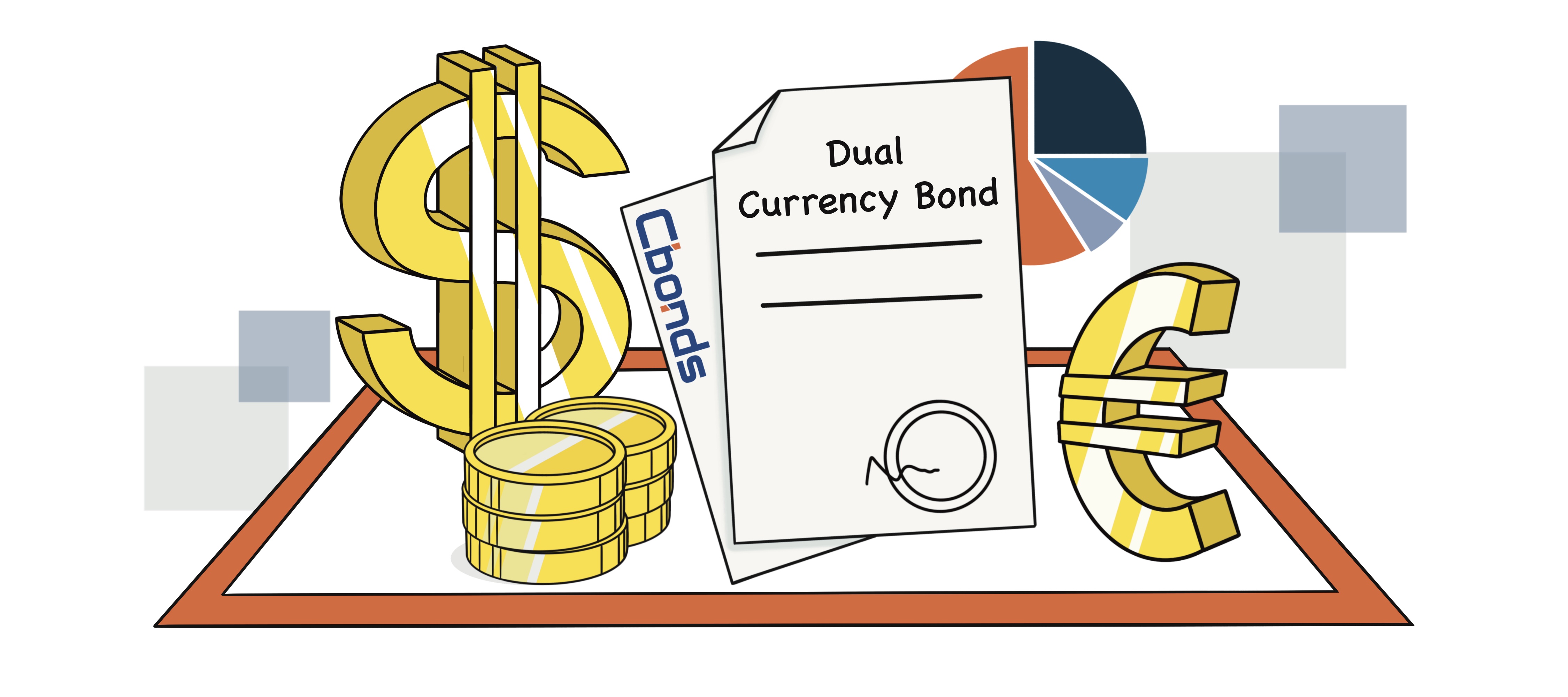Glossary
Dual Currency Bond
By Maksim Zenkov, Head of Indian Fixed Income Market of Cbonds
Updated March 31, 2024
What are Dual Currency Bonds
Dual currency bond is a debt instrument offering a distinctive approach to overseas investments. In essence, these bonds have a dual nature: coupon payments are made in a currency other than a currency of the bond face value denomination (base currency). The amount of interest to be paid is decided by converting the due amount in the base currency into the payment currency based on a relevant exchange rate.
The dual feature introduces an element of flexibility, catering to both issuers and investors who seek a balance between their currency preferences. For instance, a dual currency bond might be issued in U.S. Dollars (USD), with interest payments made in Japanese Yen (JPY), creating a fusion of two different monetary realms.

Types of Dual Currency Bonds
-
Traditional Dual Currency Bonds. In this type, interest payments are made in the investor’s domestic currency, while the principal amount is denominated in the issuer’s domestic currency.
-
Reverse Dual Currency Bonds. Conversely, in reverse dual currency bonds, interest payments are made in the issuer’s domestic currency, and the principal amount is denominated in the investor’s domestic currency.
Features
Benefits
-
Diversification. Issuers can diversify their investor base by tapping into multiple markets. Besides, if their domestic currency is relatively weak, dual currency bonds provide an opportunity to borrow in hard currencies while shifting major currency risks to the bond holders. Investors, on their part, can use such instruments to diversify their currency portfolio.
-
Attracting Investors. These bonds can attract a broader range of investors, including those who prefer returns in specific foreign currencies but prefer not to enter the overseas bond markets directly.
-
Currency Matching. Issuers can align debt obligations with specific currency revenue streams, reducing currency risk and exposure.
-
Higher Coupon Rates. Dual currency bonds often offer higher coupon rates than standard bonds, potentially providing investors with increased income.
Risks
-
Foreign Exchange Risk. Fluctuations in exchange rates between the base currency and the coupon currency can impact the value of coupon payments and the principal amount upon maturity.
-
Complexity. Dual currency bonds are more intricate than standard bonds, requiring investors to have a deeper understanding of currency dynamics and potential risks.
-
Liquidity Concerns. These bonds may have lower liquidity than major currency bonds, making them less suitable for certain investors seeking easy tradability.
Examples of Dual Currency Bond
- Yen-Linked Bonds. The par value is indicated in yen while the coupon and redemption payments are made in currencies like the US dollar or Swiss franc.
-
Masala Bonds. Denominated in Indian Rupees with coupon and redemption proceeds usually paid in the US dollar, Euro, or Japanese Yen.
-
Foreign Interest Payment Security (FIPS). Specific to the Swiss capital market, FIPS bonds have coupon payments in foreign currency while the principal is repaid in Swiss frank.
-
Multiple Currency Clause Bond. Provides investors the right to select a currency from a pre-approved list for principal and sometimes coupon payments.
-
Special Drawing Rights (SDR) Bonds. Denominated in the IMF’s composite currency based on a basket of major currencies, but traded exclusively in US dollars.
FAQ
-
What is a dual currency bond vs. a conventional bond?
A dual currency bond differentiates itself from a conventional bond through its distinctive payment structure. In a traditional bond, both the interest payments and the principal amount are denominated in the same currency. Conversely, a dual currency bond has a unique structure where the coupon and redemption payments are in one currency, while the principal amount denomination is in another. This design allows issuers and investors greater flexibility in tailoring the bond to specific currency preferences.
The primary aim of a dual currency bond is to accommodate the preferences of both parties involved in the transaction. This innovative structure caters to issuers seeking diversified funding sources and investors with specific currency-related objectives.
-
What is a multi-currency bond?
A multi-currency bond is a versatile financial instrument that allows issuers to raise capital in more than one currency, providing flexibility in meeting diverse investor preferences and accessing global markets. Unlike traditional bonds denominated in a single currency, multi-currency bonds can incorporate multiple currencies for both interest payments and principal amounts. This structure enables issuers to match their debt obligations with various revenue streams in different currencies, reducing currency risk. Investors, in turn, benefit from the opportunity to receive returns in their preferred currency.
-
What is the purpose of dual currency bonds?
The purpose of dual currency bonds lies in providing issuers and investors with a unique financial instrument that accommodates diverse currency preferences and strategic financial goals. Unlike traditional bonds, dual currency bonds offer a flexible structure where the coupon payments are denominated in one currency, and the principal amount is set in another. Via dual currency bonds, issuers can diversify their funding sources and tap into global markets using a specific form of exchange rate risk adjustment. Investors, in turn, benefit from the opportunity to take positions in foreign currency instruments while remaining under the domestic jurisdiction and using their domestic currency for investments.
Bond Screener
Watchlist
Excel Add-in
API












